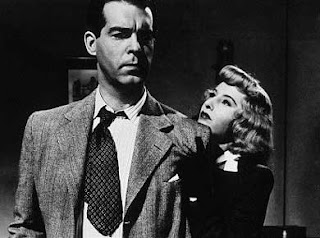 Double Indemnity
Double IndemnityA film released in 1944 starring Fred MacMurray and Barbara Stanwyck, directed by Billy Wilder.
The title sequence contains the names of those who produced and worked on the movie, with the enigmatic shadow of what appears to be a man limping forward on crutches. This creates mystery towards the figure the audience see, and the shot of the character closing ever nearer becomes quite menacing. Strong non diegetic music plays over this sequence with what sounds like drums, getting louder in effect creating a climax. The sequence then cuts to a long shot of a cross roads at night, showing a car speeding and cutting off traffic, which then defies the stop sign, connoting a sense of rushing. The car comes to a halt, and the male character is shown with his back to the screen, once again supporting that of a mysterious person as the audience cannot identify with him. The male character has a costume of a hat and a long coat, suggesting already that he is professional and a business man, although his apparant limp and one word answers suggest he may be hiding something. The male character is seen in an office with the typical noir trait of venetian blinds in the low key lighting reflecting back onto, suggesting this character has committed a crime. The non-diegetic music continues, although less menacing than before, and it ceases when the man begins to talk, connoting focus on him and his 'confession' of murder. Another element that is typical of noir films is the flashback, narrated by the man confessing how he came to have murdered someone. The previous year is shown, with the bright ambient lighting from the sun contrasting with the dark current state in which the man is narrating from presently.
Overall i think that some of the film noir elements such as the flashbacks are quite effective is used appropriately, as in thriller films this proves to work in the re-telling of how events of crime or murder unravelled, and this would be something i would want to progress with when producing our 2 minute opening sequence.




